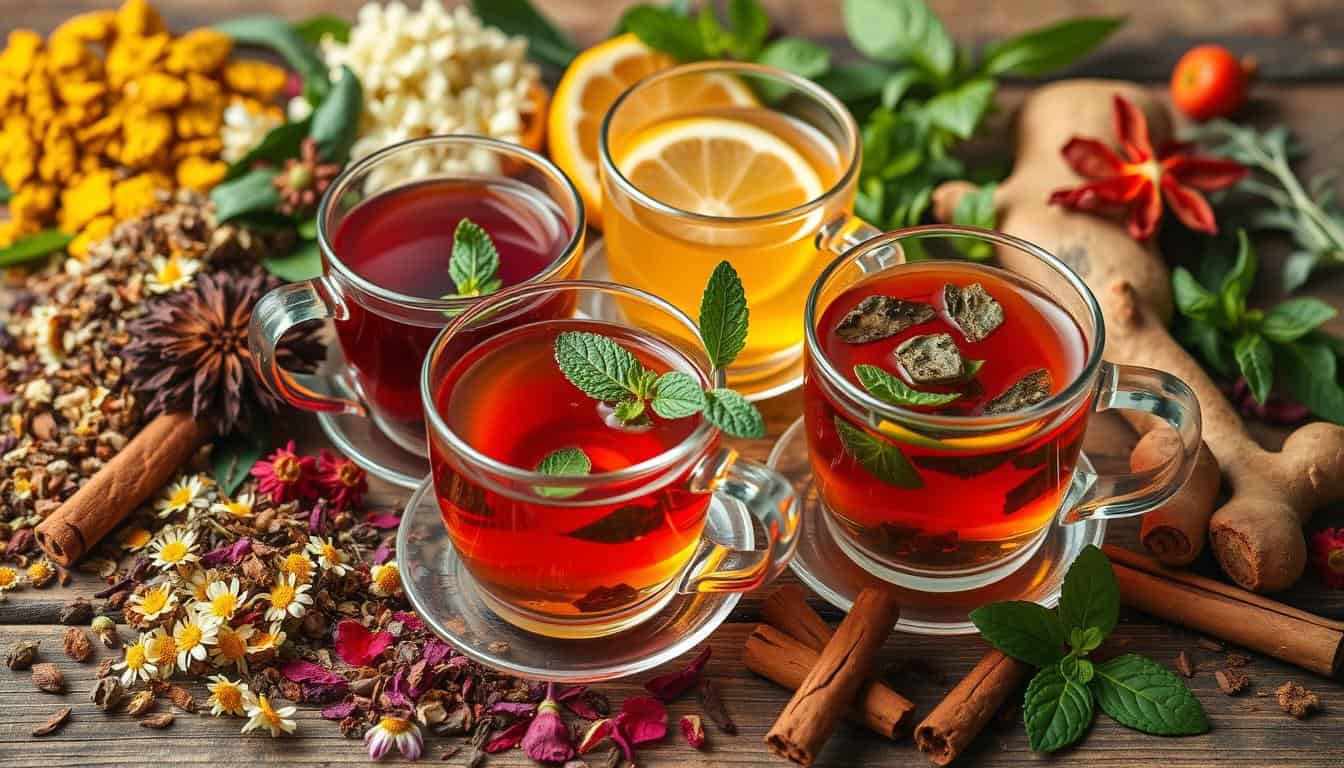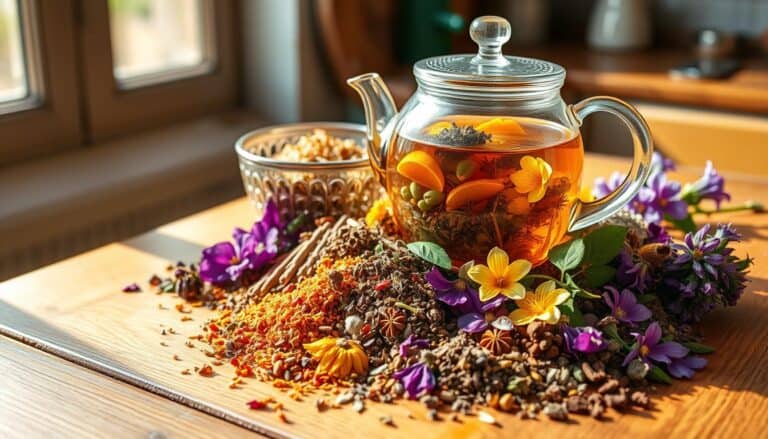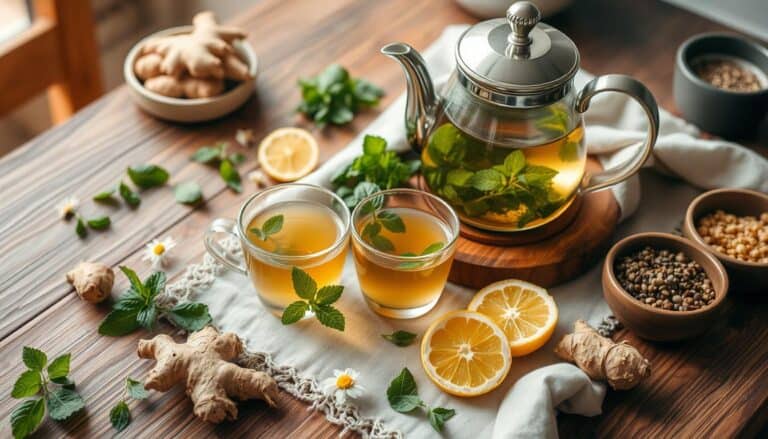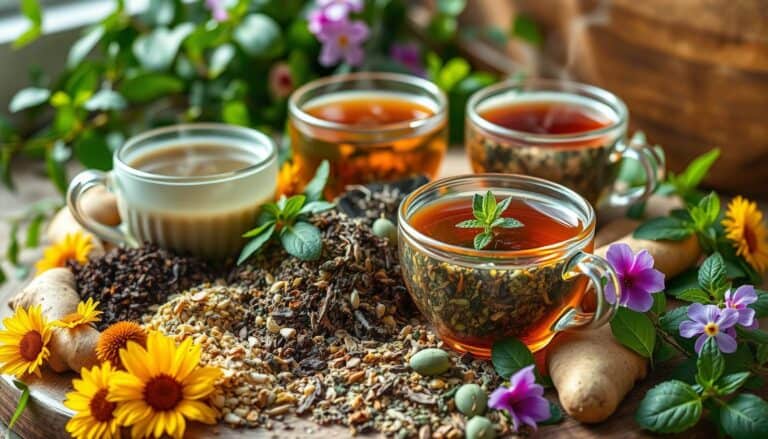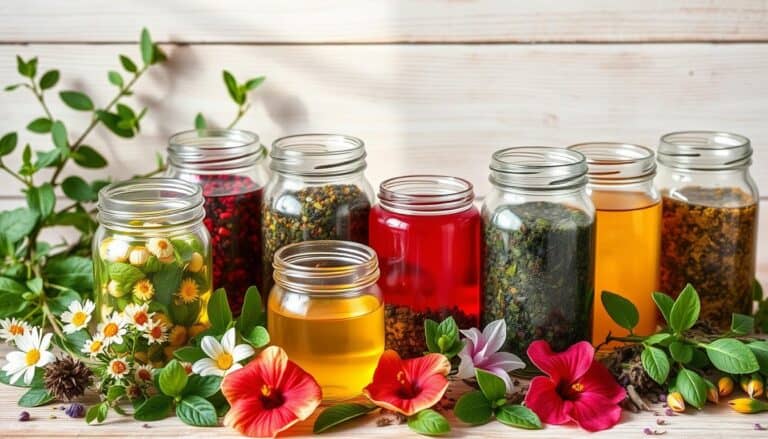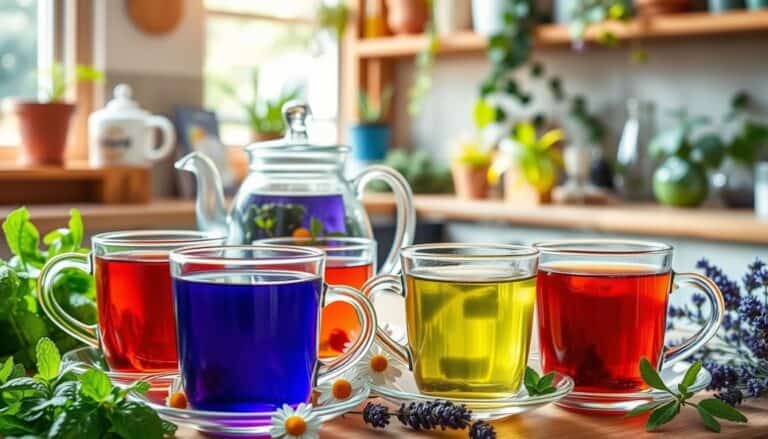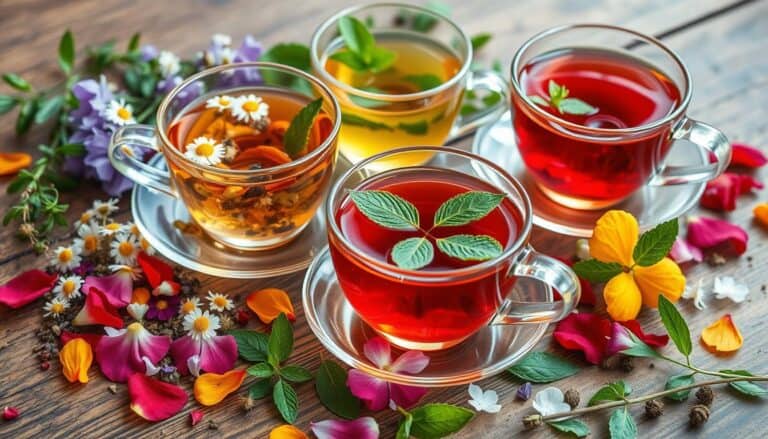12 Caffeine-Free Herbal Tea Alternatives
This post may contain affiliate links which means I may receive a commission for purchases made through links at no extra cost to you. I only recommend products I truly believe in. Thank you for your support!
Explore the world of herbal infusions, a place filled with caffeine-free drinks that are good for you and taste great. These teas are a natural choice instead of caffeinated drinks, adding wellness and calm to your day.
Herbal teas are more than just drinks. They are natural remedies with a long history of healing. Unlike teas made from the camellia sinensis plant, these options come from flowers, herbs, and other plants.
Every herbal infusion has its own special benefits. You can find everything from calming chamomile to refreshing peppermint. These teas can help with relaxation, sleep, or even digestion. So, there’s a herbal tea for everyone.
Our guide shows you 12 amazing herbal tea options. They offer great taste, nutrition, and wellness without caffeine. Get ready to discover the wonderful world of herbal infusions.
Introduction to Herbal Teas and Their Benefits
Herbal teas are a world of caffeine-free drinks that offer more than just taste. They have been loved for centuries for their unique flavors and health benefits. This makes them a great choice for those who care about wellness.
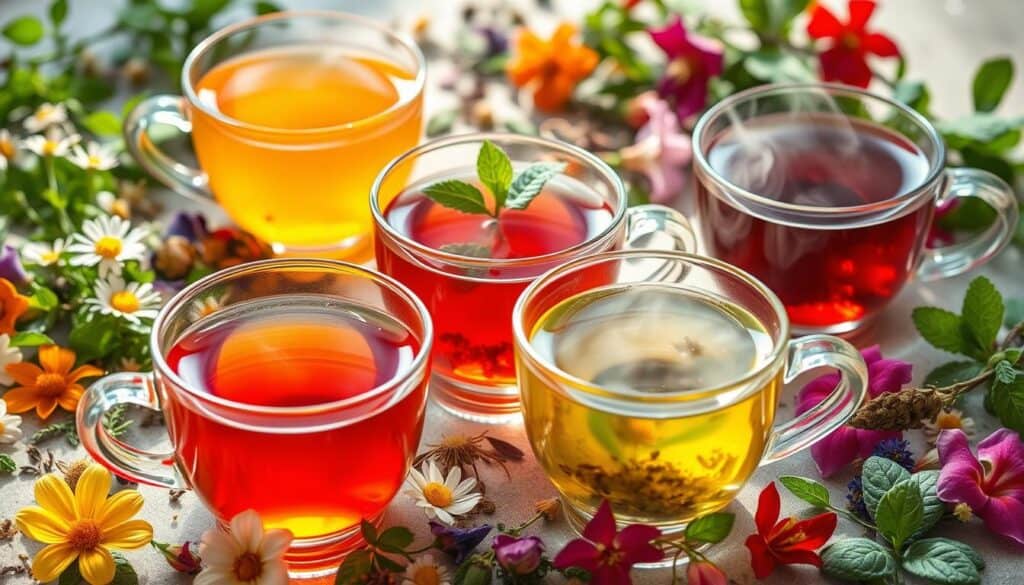
Herbal teas, also known as tisanes, are made by steeping plants in hot water. Unlike regular tea, they don’t come from the Camellia sinensis plant. This makes them naturally caffeine-free.
What are Herbal Teas?
Herbal teas come from many plants, including:
- Dried herbs
- Spices
- Fruits
- Flowers
- Seeds
- Roots
- Leaves of various plants
Health Benefits of Caffeine-Free Options
Herbal teas do more than just quench thirst. Studies show they can help with:
- Boosting the immune system
- Preventing cancer
- Improving heart health
- Reducing stress
- Helping with sleep
Common Ingredients Found in Herbal Teas
Herbal teas have ingredients with special health benefits. Here are some popular ones:
| Ingredient | Potential Health Benefits |
|---|---|
| Chamomile | Relaxation, sleep improvement |
| Peppermint | Digestive support, headache relief |
| Ginger | Anti-inflammatory, nausea reduction |
| Rose Hips | Antioxidant properties, potential arthritis pain relief |
Choosing caffeine-free teas is a tasty way to boost your health. You get to enjoy a wide range of flavors and benefits.
1. Chamomile Tea: A Soothing Classic
Explore the world of chamomile tea, a favorite for centuries. It’s not just tasty; it’s a natural way to relax and feel well.
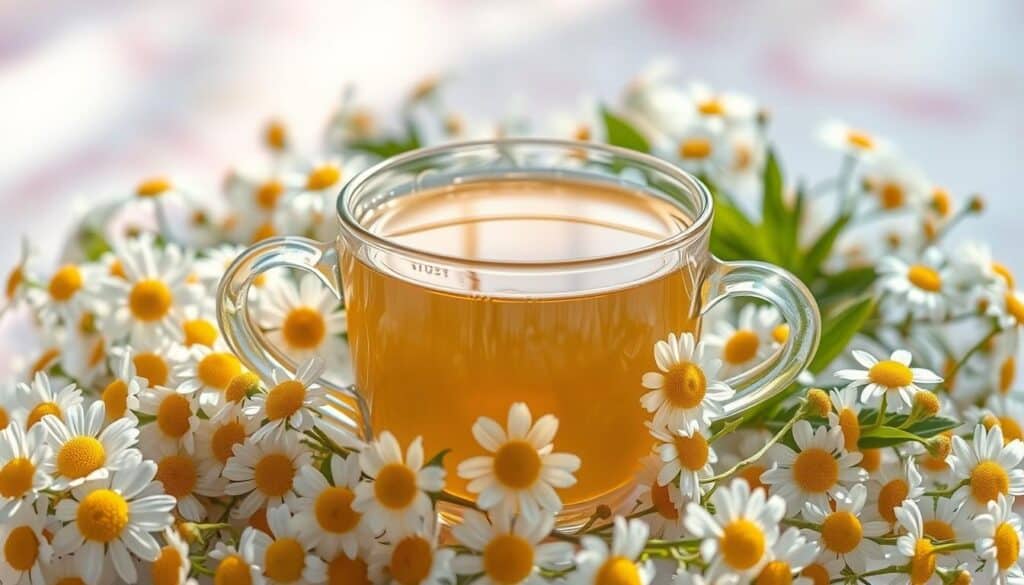
Origins and Flavor Profile
Chamomile tea comes from the flowers of the Asteraceae family. It tastes smooth, with a light sweetness and floral hints. Its benefits make it a top choice for herbal tea lovers.
Health Benefits of Chamomile
Studies show chamomile tea has many health perks:
- Reduces inflammation and supports overall wellness
- Improves sleep quality for better rest
- Helps manage blood sugar levels
- Supports mental health by reducing anxiety
One study found chamomile tea may lower thyroid cancer risk. Another showed it helps control blood sugar in diabetes patients.
How to Brew the Perfect Cup
Making chamomile tea is easy and needs little gear. Here’s how to do it right:
- Use fresh, filtered water
- Heat water to just below boiling (around 200°F)
- Steep tea for 5-7 minutes
- Remove tea bag or strain loose flowers
For a stronger taste, steep the tea for an extra minute. This lets more of the tea’s good stuff out.
Safety note: If you’re allergic to daisy family plants, talk to a doctor before drinking chamomile tea.
2. Peppermint Tea: Refreshing and Invigorating
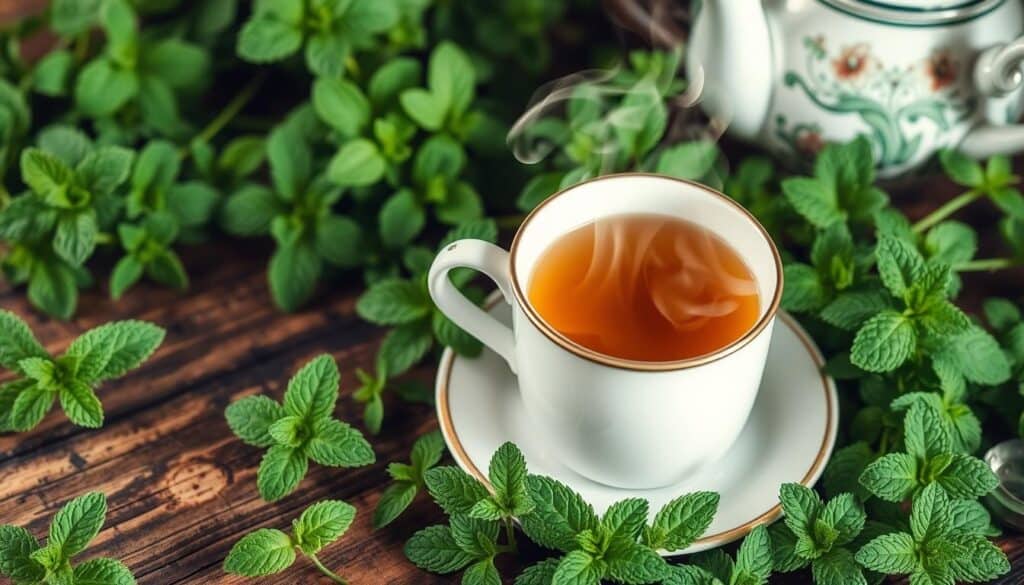
Peppermint tea is a refreshing herbal infusion that’s both tasty and good for you. It’s loved by tea lovers and health enthusiasts for its cool taste and many benefits.
History and Uses of Peppermint
Peppermint has been around for thousands of years. The Egyptians and Romans used it for its healing powers. It grows in Europe and North America and has been used for:
- Digestive support
- Breath freshening
- Stress relief
- Natural pain management
Digestive Benefits and More
Peppermint tea is more than just tasty. Studies show it can help with digestion. It may:
- Reduce bloating
- Ease stomach cramps
- Boost gut health
- Lessen nausea
Brewing Tips for Peppermint Tea
Learning to brew peppermint tea is easy and makes it even better. Here are some tips for the perfect cup:
- Use fresh or dried peppermint leaves
- Heat water to just below boiling point (around 200°F)
- Steep leaves for 5-7 minutes
- Strain and enjoy hot or cold
Looking for a caffeine-free drink or a flavorful wellness option? Peppermint tea is a great choice. It’s tasty and may offer health benefits.
3. Rooibos Tea: The South African Delight
Discover the vibrant world of rooibos tea, a remarkable herbal beverage from South Africa’s red bush plant. This caffeine-free treasure offers a unique taste experience and remarkable health benefits. It stands out from traditional teas.
Nutritional Value of Rooibos
Rooibos tea benefits go beyond its delightful flavor. It’s packed with powerful antioxidants and essential minerals. This herbal drink is a nutritional powerhouse. It contains:
- Iron for blood health
- Calcium for bone strength
- Magnesium for muscle function
- Low tannin content for easier digestion
Unique Taste Characteristics
The flavor of rooibos tea is truly distinctive. It has a naturally sweet and slightly nutty essence. This tea offers a smooth and gentle taste that appeals to many. Its rich, earthy undertones create a comforting beverage perfect for any time of day.
Popular Rooibos Blends to Try
Explore the exciting world of rooibos blends that cater to various taste preferences:
| Rooibos Blend | Flavor Profile | Best Enjoyed |
|---|---|---|
| Peach Rooibos | Sweet and fruity | Iced or hot summer afternoons |
| Vanilla Rooibos | Creamy and smooth | Evening relaxation |
| Green Rooibos | Lighter and more delicate | Morning wellness routine |
| Strawberry Mango Rooibos | Tropical and refreshing | Midday pick-me-up |
Whether you’re seeking a caffeine-free alternative or exploring natural wellness options, rooibos tea blends provide a delicious and health-conscious beverage choice.
4. Hibiscus Tea: Tart and Colorful
Hibiscus tea is a vibrant, caffeine-free drink that’s popular worldwide. It has a unique tart flavor and a bright red color. This tea is not just pretty; it’s packed with health benefits.
What is Hibiscus?
Hibiscus tea comes from the hibiscus flower’s calyces. It’s been used for thousands of years in medicine and cooking. The tea is known for its deep red color and tangy taste. It’s great hot or cold, making it a refreshing choice for summer.
Health Benefits and Nutritional Content
Hibiscus tea is full of antioxidants like vitamin C and flavonoids. It’s good for your heart and blood sugar levels. Studies show it might lower blood pressure and fight inflammation.
Serving Suggestions for Hibiscus Tea
To enjoy hibiscus tea, use loose-leaf or high-quality tea bags. Add a bit of monk fruit sweetener or lime juice to sweeten it. It’s perfect hot or over ice, offering a healthy drink choice.
